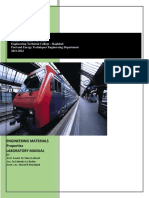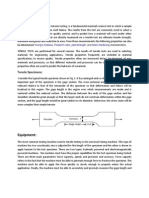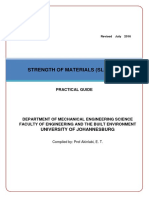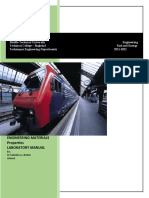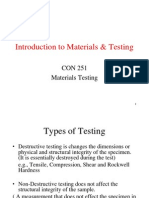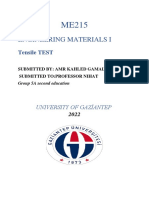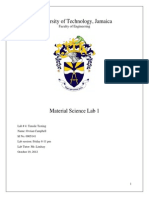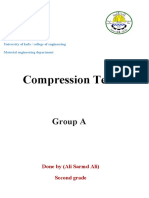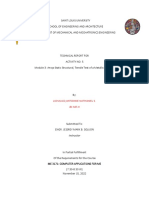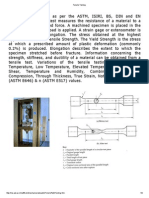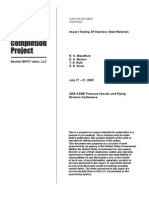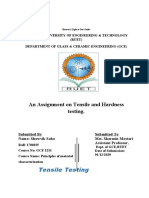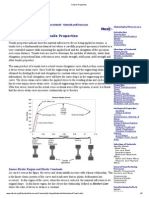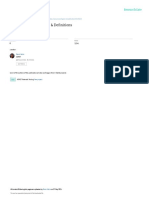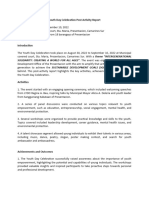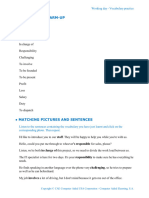Tension Lab
Tension Lab
Uploaded by
WilliamMermellCopyright:
Available Formats
Tension Lab
Tension Lab
Uploaded by
WilliamMermellOriginal Description:
Copyright
Available Formats
Share this document
Did you find this document useful?
Is this content inappropriate?
Copyright:
Available Formats
Tension Lab
Tension Lab
Uploaded by
WilliamMermellCopyright:
Available Formats
Introduction:
Tensile tests are very useful for learning the basic mechanical behavior of materials.
Specifically, tensile tests relate uniaxial stress and strain. In other words, this means the
relationship between an applied tensile load and the deformation in the direction of that load.
The basic tensile test is conducted by loading a test specimen in tension and gradually
increasing the tensile force until the specimen fractures apart. An extensometer is used to
measure the specimens elongation. From this data, a stress-strain curve is generated, and the
materials Youngs Modulus, yield stress, ultimate stress, and fracture stress can be calculated.
Furthermore, additional qualitative information is available by looking at the relative shape of
the stress-strain curve generated, such as whether the material is more ductile or brittle, and
tough or weak. For these reasons, the tensile test is very useful to engineers and scientists
working on the design, manufacture, or use of materials for many purposes. It is important for
those working with materials to know the basic mechanical characteristics of these materials
and how they compare with other materials. Therefore, the purpose of this experiment is to
evaluate and compare the tensile behaviors of several common engineering materials.
Theory:
Quite simply, stress is defined as force per area and strain is defined as a change in
length per length. However, there are two methods of defining stress and strain; engineering
stress/strain and actual stress/strain. Engineering stress/strain calculations use the original
specimen dimensions, whereas actual stress/strain calculations use the materials actual
dimensions as it is changing over the duration of the test.
eq. 1 eq. 2
eq. 3 eq. 4
For the purposes of generating stress-strain curves from the tensile test, engineering
stress/strain calculations are used. Besides this difference, there is other some other
differences in how stress and strain are defined. In three-dimensions, there are infinitely many
possible combinations of stress and strain. To simplify all these combinations into one
definition, stress and strain are both tensors that are defined in a given coordinate system in
terms of their direction and the cross sectional area theyre acting on. For the purposes of the
basic tensile test, things are kept simple and the only stress and strain combination studied is
the normal strain and normal stress in one dimension. To accomplish this, the test specimen is
fixed into position in line with the direction of applied force and can only move in the direction
of applied force. This is very important to ensure that relevant measurements are obtained,
namely the one-dimensional stress and strain in the direction of applied force. Furthermore, to
ensure other mechanical effects, such as strain rate, are not affecting the results, the testing
machine carefully and slowly stretches the specimen, in small increments until fracture occurs.
Strain is the independent variable because it is important to keep level, precise, and evenly
spaced increments of strain for good material data. Throughout the course of the test, the
machine records the applied load and an extensometer measures the specimens deformation.
For each stretch increment, engineering stress and strain are calculated using equations 1 and
2. From this data, a stress-strain curve is generated.
Once the stress-strain curve is generated, the materials Youngs Modulus, yield stress,
ultimate stress, and fracture stress is calculated, and the materials qualitative characteristics
are discerned. The stress-strain curve has an initial linear region, known as the elastic region,
a non-linear curved region, known as the plastic region, and then a fracture point where the
curve ends. The slope of the linear elastic region is the materials Youngs Modulus and
represents the constant in Hookes Law (in 1-Dimension). The yield point separates the linear
elastic region from the non-linear plastic region. To ensure uniformity across all materials, and
to reflect the fact that theres no real point where the curve instantly changes from linear to
non-linear, the yield point is calculated using a 0.2% offset; (following a line with a slope of the
Youngs Modulus up from a strain of 0.002 to where the line intersects the stress-strain curve).
The stress at this intersection is the Yield Stress. The Ultimate Stress is simply the maximum
engineering stress measured in the material, and the fracture stress is the engineering stress
when the material fractures. Besides these data points, the relative shape of the stress-strain
curve shows whether a material is ductile or brittle and strong or weak. A ductile material has a
large plastic region, whereas a brittle material has a small or non-existent plastic region. A
strong material has large area under the curve, whereas a weak material has a small area under
the curve.
Measurement Methods:
Testing machineused to apply the load
Extensometerused to measure the strain
Materialsacrylic, aluminum, steel and copper.
The testing machine is zeroed, then the material is securely loaded into the testing machine,
and then, the is extensometer placed on the material, and finally the test proceeds until
material fracture.
Results/Analysis:
(See attached graphs and spreadsheets)
In general, there is a direct relationship between density and tensile strength. The
denser a material is, the greater its tensile strength, but not always. An aerospace engineer is
typically most concerned with a materials strength-to-weight ratio, as high strength and low
weight are very important for airplanes to ensure theyre strong enough to travel at high
speeds, yet light enough to save on fuel costs.
Also, steel and aluminum alloys can have a varying range of mechanical properties and
stress-strain relationships depending upon the manufacturing method. Cold Working processes
such as strain hardening result in a greater Youngs Modulus and greater yield strength, but a
smaller plastic region, hence a more brittle material. Hot Working Processes such as annealing
result in a decreased Youngs Modulus and decreased yield strength, but a larger plastic region,
hence a more ductile material. Besides the strength to weight ratio, an engineer designing an
aerospace or mechanical system has other parameters to consider when choosing materials,
such as the environmental factors (operating temperature, oxygen levels, smooth or turbulent
air flow) and mechanical factors (steady state system or cyclic system). For example, airplane
wings have to be designed to handle stresses that result from turbulent airflow. As long as the
maximum stress that could result from this airflow is less than the yield stress, a strain
hardened material would probably handle better in this situation than a cold-worked material,
since the cold worked material will deform too easily.
Discussion:
The lab met the expectations of performing a tensile test of common engineering
materials, constructing reasonably accurate stress-strain curves from the data, and evaluating
and comparing the tensile behaviors these materials. While there is some variance between the
experimental and theoretical values of yield strength, ultimate strength, and Youngs Modulus,
the stress-strain curves have the correct character for the respective materials. The results are
indeed consistent with other relevant, published data. The variances in experimental and
theoretical values were mostly within the accepted ranges, according to matweb.com.
Importantly, variances in experimental and theoretical values are expected in a tensile test,
since there are so many different kinds of steel, aluminum, copper, and acrylic. In particular,
theres not really any such material as acrylic, and theres over a hundred different kinds of
materials classified as acrylic. Depending upon chemical impurities and the manufacturing
process (whether the material is hot worked or cold worked, rolled or extruded, etc.), there are
a range of excepted values.
There are a few possible sources of error in this experiment. Most important, is the
placement of the test specimen. A tiny angle between the direction of applied force and the
direction of the test specimen can have a drastic effect on the data obtained. Also, the
misalignment or miscalibration of the extensometer or the testing machine itself can cause
errors through inaccurate length and force measurements. Another source of error is sample
selection. Instead of mostly metals, other types of materials, such as more plastics, or even
ceramics would have allowed more extensive comparison of stress-strain curves, as metals are
mostly ductile and strong, ceramics mostly brittle and strong, and plastics obviously very plastic
and typically the weaker of these three types of materials.
The lab can definitely be improved if the exact kind of material is known as there are so
many different varieties of steel, copper, aluminum, and especially acrylic.
Most materials failed due to necking, except acrylic which failed in a brittle manner. In
necking failure, you can see a reduction in final cross-sectional area, and in brittle failure you
observe a rougher surface and small pieces of material that actually broke off from the
specimen.
Conclusion:
The lab was definitely a success in being able to construct reasonably accurate stress-
strain curves, and evaluate and compare the tensile properties of different engineering
materials. These curves could then be used to select a material based upon the desired design
properties.
You might also like
- Lab Tensile UTHMDocument27 pagesLab Tensile UTHMMuhd Farhan Bin Ibrahim100% (1)
- Introduction To Materials TestingDocument6 pagesIntroduction To Materials Testinggosaye desalegn100% (1)
- Strength of Materials ReportDocument14 pagesStrength of Materials ReportRahul JohnsonNo ratings yet
- Destructive TestingDocument8 pagesDestructive TestingAbdul Rehman100% (3)
- Summary About SMAT ArticleDocument2 pagesSummary About SMAT Articleariana religiosoNo ratings yet
- Tensile Testing by Odewole TemidayoDocument10 pagesTensile Testing by Odewole Temidayostephenoladipo21No ratings yet
- Uniaxial Tension TestingDocument6 pagesUniaxial Tension Testinganil chejara100% (1)
- ملزمة العملي للخواصDocument69 pagesملزمة العملي للخواصyousifNo ratings yet
- Altinbas University Industrial Engineering Ie258 Manufacturing Process Lab. Tension, Bending, Compression and Torsion TestDocument19 pagesAltinbas University Industrial Engineering Ie258 Manufacturing Process Lab. Tension, Bending, Compression and Torsion TestHusam JARRAR100% (1)
- Tensile TestingDocument4 pagesTensile TestingNaveed AfzalNo ratings yet
- 2016 Practical Guide PDFDocument9 pages2016 Practical Guide PDFPromiseDoringtenNkosiNo ratings yet
- Tensile TestDocument15 pagesTensile TestLilac ClassNo ratings yet
- Material LabDocument5 pagesMaterial LabNELMIDA AIRISH JOY N.No ratings yet
- Tensile TestDocument9 pagesTensile Testonkod1No ratings yet
- Tension Test (Bustamante)Document21 pagesTension Test (Bustamante)Marjorie Ramirez BustamanteNo ratings yet
- Exp-1 Tension Test PDFDocument8 pagesExp-1 Tension Test PDFHanamant HunashikattiNo ratings yet
- Solids and Structural MechanicsDocument15 pagesSolids and Structural MechanicsBONFACE MUGUNANo ratings yet
- E45 Laboratory1Document10 pagesE45 Laboratory1nickNo ratings yet
- Tensile Testing: Mechanical Engineering LaboratoryDocument7 pagesTensile Testing: Mechanical Engineering LaboratoryChandra Wahyu SetiawanNo ratings yet
- Engineering Materials Properties Laboratory Manual: BY: DR - Sabeeha A.J.Beden AhmedDocument66 pagesEngineering Materials Properties Laboratory Manual: BY: DR - Sabeeha A.J.Beden Ahmedb964 SpeedNo ratings yet
- Tensile TestDocument6 pagesTensile TestMohamed EmadNo ratings yet
- Mechanical PropertiesDocument57 pagesMechanical PropertiesElmedin Gluhic100% (1)
- Eng 45 Lab 2Document6 pagesEng 45 Lab 2Anonymous qOXAfbUONo ratings yet
- Tensile Testing Asm StandardDocument13 pagesTensile Testing Asm StandardNinad PawarNo ratings yet
- Lecture 2 Mechanical TestingDocument30 pagesLecture 2 Mechanical TestingDika AnggaraNo ratings yet
- Tensile Test - Intro & TheoryDocument8 pagesTensile Test - Intro & TheoryaidasuhanumNo ratings yet
- Tensile Test AmrDocument5 pagesTensile Test AmrAmr KhaledNo ratings yet
- Real O.V Tensile TestingDocument14 pagesReal O.V Tensile TestingOshane ThomasNo ratings yet
- Universaltestingmachines PDFDocument27 pagesUniversaltestingmachines PDFarulmuruguNo ratings yet
- Lab ManualDocument21 pagesLab ManualAASIM ALINo ratings yet
- Lab Tensile TestDocument8 pagesLab Tensile TestYomal WijesingheNo ratings yet
- Tensile Testing PropertiesDocument6 pagesTensile Testing PropertiesSyed Mujtaba Ali BukhariNo ratings yet
- Stress Strain DiagramDocument8 pagesStress Strain DiagramezraNo ratings yet
- Materials Engineering: Pangasinan State University Urdaneta Campus Mechanical Engineering DepartmentDocument7 pagesMaterials Engineering: Pangasinan State University Urdaneta Campus Mechanical Engineering DepartmentiamjemahNo ratings yet
- Compression TestDocument8 pagesCompression TestKaneki SSSNo ratings yet
- MEEN 2145 For SLCCDocument10 pagesMEEN 2145 For SLCCCarlos Artiles Fortún100% (1)
- ENCI 317 - LAB 1 - Lab MaterialDocument15 pagesENCI 317 - LAB 1 - Lab MaterialSherry YousafNo ratings yet
- Lichauco Activity5ansysDocument14 pagesLichauco Activity5ansysNATHANIEL YACASNo ratings yet
- Fatigue DeterminationDocument5 pagesFatigue DeterminationMichael JayNo ratings yet
- Tensile TestingDocument9 pagesTensile Testingdwimukh360No ratings yet
- Identifying Unknown SamplesDocument12 pagesIdentifying Unknown SamplesJason Paul RoqueNo ratings yet
- Experiment 1-Tensile TestDocument7 pagesExperiment 1-Tensile Testhazriel83% (6)
- Compression TestDocument4 pagesCompression Testjazille2267% (3)
- Solid Mechanics 20ME006Document72 pagesSolid Mechanics 20ME006Prathmesh AwaghadeNo ratings yet
- Impact Testing of Stainless Steel Materials: ICP/CON-04-00633 PreprintDocument10 pagesImpact Testing of Stainless Steel Materials: ICP/CON-04-00633 Preprintbabis1980No ratings yet
- Tensile Test PresentationDocument36 pagesTensile Test PresentationalkharfaneNo ratings yet
- Design and construct a Horizontal tensile testing machine for polymer compositesDocument49 pagesDesign and construct a Horizontal tensile testing machine for polymer compositeschinweubaonovoNo ratings yet
- 01 CVNG 1005 - Materials LabDocument6 pages01 CVNG 1005 - Materials LabMarly MarlNo ratings yet
- Tensile and Hardness Testing (1706025)Document16 pagesTensile and Hardness Testing (1706025)ShowvikNo ratings yet
- Tensile PropertiesDocument4 pagesTensile Propertiesjontylee87No ratings yet
- Lab#1 - Tensile Test HandoutDocument7 pagesLab#1 - Tensile Test Handoutgrbxjgsh59No ratings yet
- Ceg 201 Lab ReportdddDocument21 pagesCeg 201 Lab ReportdddEmenike-Ukah Michael ChiedozieNo ratings yet
- Tensile Testing Concepts DefinitionsDocument12 pagesTensile Testing Concepts Definitions04Musyaffa Nafis MNo ratings yet
- Exp 1 G5Document24 pagesExp 1 G5Abdullah Helmi100% (1)
- Tensile Testing Concepts DefinitionsDocument12 pagesTensile Testing Concepts DefinitionsPremNo ratings yet
- Lab05 Candy LabDocument14 pagesLab05 Candy LabJason Paul RoqueNo ratings yet
- Compression TestingDocument6 pagesCompression TestingCheri Arranz ColleraNo ratings yet
- Module 3Document23 pagesModule 3MARYVELLE AIZEN SAMSONNo ratings yet
- The Mechanical Properties of Wood: Including a Discussion of the Factors Affecting the Mechanical Properties, and Methods of Timber TestingFrom EverandThe Mechanical Properties of Wood: Including a Discussion of the Factors Affecting the Mechanical Properties, and Methods of Timber TestingNo ratings yet
- Vacuum Trip Setting, Condenser PressureDocument2 pagesVacuum Trip Setting, Condenser PressurednbinhNo ratings yet
- 1 KabelDocument7 pages1 KabelSayuti SidikNo ratings yet
- Deutz TD 4l2009 Engine Parts Manual 913282b Rs5 19 Telescopic HandlerDocument4 pagesDeutz TD 4l2009 Engine Parts Manual 913282b Rs5 19 Telescopic Handlerflorine100% (58)
- Tabel Covid Juni - Agusrsud E.H.D (Ket Pns&nonpnsDocument19 pagesTabel Covid Juni - Agusrsud E.H.D (Ket Pns&nonpnsBerkah FarmaNo ratings yet
- 10 EMI 04 The PIC Micro ControllerDocument20 pages10 EMI 04 The PIC Micro Controllerapi-3707706100% (1)
- Curriculum Vitae: Personal DetailsDocument4 pagesCurriculum Vitae: Personal DetailsCuhp FbliveNo ratings yet
- 201206290024244fecf5b80d1b0Document17 pages201206290024244fecf5b80d1b0palanaruva100% (1)
- SHAHEEN-COM-ME-SPC-1093-0 - Addendum For Proportioning Pump of Reciprocating TypeDocument4 pagesSHAHEEN-COM-ME-SPC-1093-0 - Addendum For Proportioning Pump of Reciprocating TypeOliver JimmyNo ratings yet
- Help2Go Recommended Software ListDocument14 pagesHelp2Go Recommended Software ListthepillquillNo ratings yet
- Effects of Entrained Hydrocarbon and Organic-Matter Components On Reservoir Quality of Organic-Rich Shales (Copy)Document26 pagesEffects of Entrained Hydrocarbon and Organic-Matter Components On Reservoir Quality of Organic-Rich Shales (Copy)FrancyNo ratings yet
- Cohen Osburn: Contact ProfileDocument1 pageCohen Osburn: Contact Profileapi-670774418No ratings yet
- SMART Communication: An Emerging Era of CommunicationDocument7 pagesSMART Communication: An Emerging Era of CommunicationInternational Journal of Innovative Science and Research TechnologyNo ratings yet
- Coe Ee 22Document7 pagesCoe Ee 22Trần Minh ĐứcNo ratings yet
- Mechanical Lab Requirement R21Document10 pagesMechanical Lab Requirement R21KARUPPASAMYNo ratings yet
- PDF Foundations For Analytics With Python 1St Edition Clinton W Brownley Ebook Full ChapterDocument53 pagesPDF Foundations For Analytics With Python 1St Edition Clinton W Brownley Ebook Full Chapterken.carone995100% (4)
- English - II Project by PrateekDocument7 pagesEnglish - II Project by PrateekBlackster GamingNo ratings yet
- Urban Land Use Patterns & Land Forms - Basic Urban Form Conceptual FrameworksDocument10 pagesUrban Land Use Patterns & Land Forms - Basic Urban Form Conceptual FrameworksRitchelle Ann GregorioNo ratings yet
- Ick Work - Partition Layout (First Floor)Document1 pageIck Work - Partition Layout (First Floor)Shubham PokhriyalNo ratings yet
- Youth Day Celebration Post Activity ReportDocument2 pagesYouth Day Celebration Post Activity ReportVitaliano Francia, Jr. IINo ratings yet
- Brief About The Scheme: Project Based Support To Autonomous Institutions-National Institutes of Design (NID)Document10 pagesBrief About The Scheme: Project Based Support To Autonomous Institutions-National Institutes of Design (NID)Sakshi SanaNo ratings yet
- Zimbabwe GoodpracticeDocument3 pagesZimbabwe GoodpracticeTapedza ZhouNo ratings yet
- Narrative Report Field StudyDocument3 pagesNarrative Report Field StudyJennie UrbanoNo ratings yet
- Foam Agent Field ManualDocument11 pagesFoam Agent Field Manualnap_carino100% (2)
- FinalBook3 ManagementDynamicsCOVIDPandemicDocument369 pagesFinalBook3 ManagementDynamicsCOVIDPandemicAgneesh DuttaNo ratings yet
- Company Data For Placement Training (BM DEPT)Document33 pagesCompany Data For Placement Training (BM DEPT)Kriti SinhaNo ratings yet
- A Brief Guide To Writing Social TheoryDocument5 pagesA Brief Guide To Writing Social TheoryFernando Antonio UchoaNo ratings yet
- Aqa 84031 QP Jun15 PDFDocument28 pagesAqa 84031 QP Jun15 PDFdadajee420No ratings yet
- Tema 26 - EDocument10 pagesTema 26 - EUsuario apellidoNo ratings yet
- Soh Cah Toa FDocument4 pagesSoh Cah Toa FFareena ArshadNo ratings yet
- PM Change OutDocument11 pagesPM Change OuttmmehtaNo ratings yet








